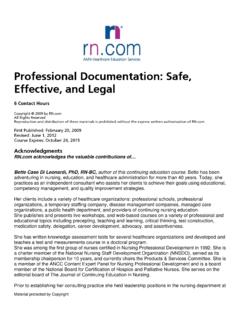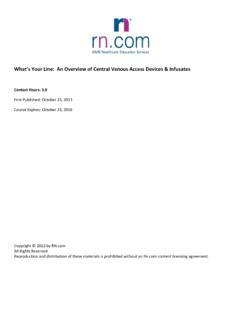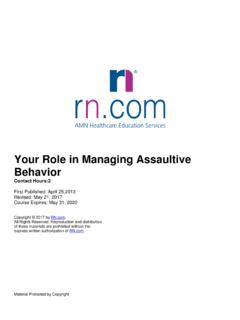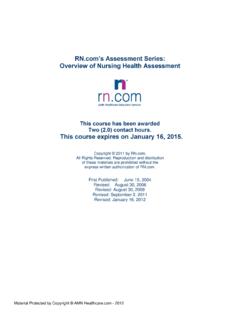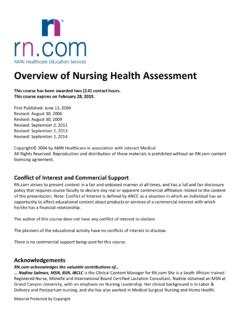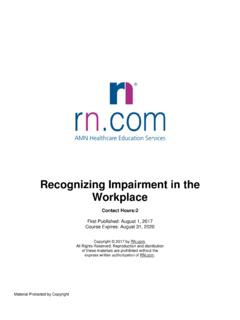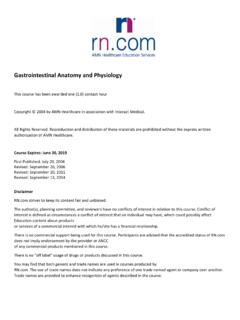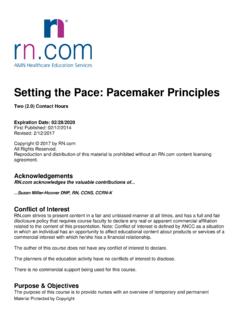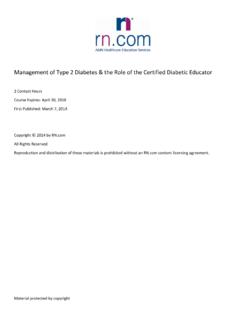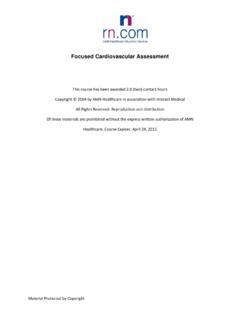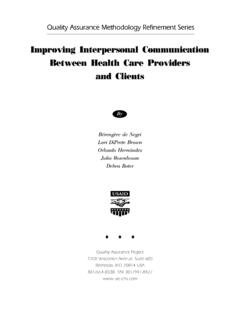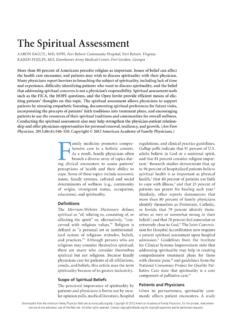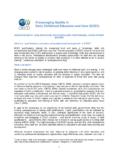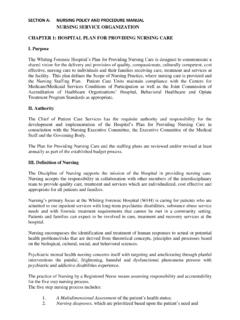Transcription of Age-Specific Considerations in Patient Care
1 Material Protected by Copyright Age-Specific Considerations in Patient care This course has been awarded two ( ) contact hours. This course expires on December 30, 2014. Copyright 2004 by All Rights Reserved. Reproduction and distribution of these materials are prohibited without the express written authorization of First Published:October 27, 2004 Revised Date: October 1, 2007 Revised Date: December 30 2011 Material Protected by Copyright IMPORTANT INFORMATION strives to keeps its content fair and unbiased. The author has no conflicts of interest to disclose. The planners of the educational activity have no conflicts of interest to disclose.
2 (Conflict of Interest Definition: Circumstances create a conflict of interest when an individual has an opportunity to affect Education content about products or services of a commercial interest with which he/she has a financial relationship.) There is no commercial support being used for this course. Participants are advised that the accredited status of does not imply endorsement by the provider or ANCC of any products/therapeutics mentioned in this course. The information in the course is for educational purposes only. There is no off label usage of drugs or products discussed in this course. Acknowledgements acknowledges the valuable contribution ..Nadine Salmon, RN, BSN, IBCLC is the Clinical Content Specialist for Nadine earned her BSN from the University of the Witwatersrand, Johannesburg, South Africa.
3 She worked as a midwife in Labor and Delivery, an RN in Postpartum units and Antenatal units, before moving to the United Kingdom, where she worked as a Medical Surgical Nurse. After coming to the US in 1997, Nadine worked in obstetrics and became a Board Certified Lactation Consultant. Nadine was the Clinical Pre Placement Manager for the International Nurse Staffing division before joining When not writing courses and other educational materials, Nadine is currently pursuing her master s degree in Nursing Leadership.. Bette Case Di Leonardi, BSN, MSN, PhD is the original author of this continuing nursing education course. Since 1993, Bette has practiced as an independent consultant to a broad spectrum of healthcare organizations.
4 Bette presents continuing education offerings at a variety of national and regional conferences. She has published on the topics of critical thinking, test construction, competency testing, precepting and career development. She has also written numerous continuing education Self-study courses and prepared competence tests for a variety of nursing specialties. She serves on the editorial board of the Journal of Continuing Education in Nursing and on a regional advisory board for Advance Magazines. Prior to establishing her consulting practice, she held leadership positions in the school of nursing and the nursing department at Michael Reese Hospital and Medical Center in Chicago, IL.
5 She has taught nursing students of all levels and college of education students. As a practicing nurse she enjoyed the roles of staff LPN, medical surgical staff nurse, school health nurse and camp nurse. Material Protected by Copyright She is an active member of the Nursing Staff Development Organization (NNSDO) and was among the first group of nurses to receive certification in Nursing Staff Development and Continuing Education from the American Nurses Association Credentialing Center (ANCC). She earned her BSN at Syracuse University and her MSN and in educational psychology at Loyola University of Chicago. Purpose and Objectives 1. Explain what is meant by the term: Age-Specific competency.
6 2. Identify Age-Specific differences in the nurse s response to a Patient s rights and basic needs. 3. Identify nursing actions that differ among age groups based upon physical and Motor/sensory differences. 4. Identify nursing actions that differ among age groups based upon cognitive differences. 5. Identify nursing actions that differ among age groups based upon psychosocial and developmental differences. 6. Name nursing actions that reduce risks to which specific age groups of Patient are vulnerable. 7. Explain how a Patient s individual characteristics other than age, such as culture or work role may combine with Age-Specific Considerations in nursing actions. After successful completion of this course, you will be able to: The purpose of Age-Specific Considerations in Patient care is to provide healthcare professionals with information about different age groups, how to identify needs related to these age groups, and how to vary approaches to Patient care with age specific needs in mind.
7 Introduction Information in this course is culled and synthesized from several credible references and represents generally accepted characteristics of various age groups. Your Patient has no hair on his head. He does not speak. Your nursing care for him will include feeding him and changing his diaper. Do you have a mental picture of this Patient ? Do you imagine a normal newborn? A brain injured teen-ager post-neurosurgery? A middle-aged man who has received surgical and chemotherapy treatments? An elderly man who has had a cerebrovascular accident? The description might fit any of those patients. However, you care for each one quite differently because each age group has unique characteristics and needs: physical, including motor/sensory attributes; psychosocial and developmental tasks; cognitive and intellectual functioning, and major fears and stressors.
8 Age-Specific Competency Requirements The Joint Commission (TJC) assesses competence of facility staff as a part of the accreditation process. To comply with standards related to staff competence, facilities must define the Patient Material Protected by Copyright population served, the age and special needs groups within the Patient population, and the staff members who deliver services to the Patient population. Further, TJC clarifies that the hospital must assess competency of staff members, clearly addressing the special needs and behaviors of specific age groups of the patients whom they serve. Each facility has defined age groupings of the population it serves. Many hospitals designate the following four categories: Neonatal and infant Child and adolescent Adult Geriatric However, some facilities identify additional subcategories depending upon the population served.
9 Specialty organizations such as the American Academy of Pediatrics and The John A. Hartford Foundation for Geriatric Nursing recognize additional age groupings of pediatric patients and geriatric patients. Age-Specific Competency Requirements Know the framework used in your facility and the age group served by your Patient care area. In addition, locate and use the specialized assessment tools pertinent for patients in the age group for whom you provide nursing care . Examples include pediatric pain assessment tools, cognitive assessment tools for elders, and fall risk assessment tools. Refer to the policies and procedures your facility has created to guide the use of specific tools.
10 Each state has laws governing age-related implications for healthcare professionals. Learn the requirements of the laws of your state related to treatment of minors and reporting child abuse, domestic abuse and elder abuse. Your state Nurse Practice Act and Rules and Regulations will contain most, if not all, of this information. The policies and procedures of your facility give direction for complying with these and other age-related legal requirements. Continually update your knowledge of health risks and safety precautions specific to the age group of patients with whom you work. Know the normal findings for physical assessment, laboratory and other diagnostic tests specific to the age group to whom you provide care and the specialty in which you work that level of detail is beyond the scope of this course.
